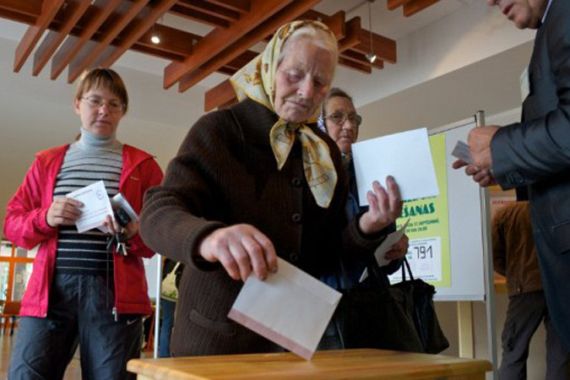For Latvia, it’s time to form a new coalition
The pro-Russian Harmony Centre won the most votes in recent elections, but other parties may block it from taking power.

 |
| On September 17, Latvian voters elected a new parliament; a pro-Russian party was the clear winner [AFP] |
The timing for Latvia’s parliamentary elections this past Saturday was unfortunate for many. Drastic austerity measures and unpopular government policies did not provide the electorate with an optimal choice. In addition, the complicated social-economic situation made the elections’ results somewhat unpredictable.
In the new parliament, the 100 MPs were elected from five Latvian regions: 30 from Riga, 27 from Vidzeme, 15 each from Latgale and Zemgale, and 13 from Kurzeme.
For the first time in two decades of independence, the Harmony Centre, a party backed by Latvia’s Russian-speaking population, polled highest, winning 31 seats, compared with just 22 seats won by its closest rival, former president Valdis Zatlers’ Reform Party. But politicians may yet find a way to block Harmony Centre from leading: the Reform Party, the Unity Party and the All for Latvia/For Fatherland and Freedom party (abbreviated as VL/LNNK) could make a coalition to force Harmony Centre into opposition.
It was clear before the vote that no single party could win a majority of the vote. Instead, under the difficult economic conditions currently prevailing in the country, the only way to find a “common course” would be through forming a coalition, ie, as many Latvians thought: between Zatlers’ Reform Party, the Unity Party and the VL-LNNK bloc.
The preliminary election results show that this potential alliance managed to get more than half of the votes: The Unity and Reform Parties got about 20 per cent each and VL/LNNK received more than 14 per cent.
According to the Russian government’s Voice of Russia news service, Riga mayor and Harmony Centre leader Nil Ushakov has said he is ready to form and lead a government coalition. Despite this, Andris Bersinsh, Latvia’s conservative president, is expected to nominate current Prime Minister Valdis Dombrovskis for another term in office.
 |
| No one party could have won a majority – only a carefully constructed coalition will be able to take power [EPA] |
The elections mirage
The electoral campaign has faced at least three problematic issues. First, the electorate’s activity: During the past two decades, only 60-65 per cent of eligible voters actually cast ballots. On the eve of this year’s election, about one-fifth of the population had still not made up their minds.
Second, “negative participation” has become popular. Latvian voters can vote for a “useless party-list” – essentially a “none of the above” option. If they do so, the vote is still counted as valid, making it more difficult for parties to obtain the five per cent of the vote necessary to seat members of parliament.
The third issue is the composition of the would-be parliamentary groups and factions. In the previous parliament, the most popular politician could acquire about 77,000 votes whereas the least popular gained just 22,000.
Strangely enough, forming a governing coalition in Latvia has always been an informal process. In the night after the preliminary election results become known, influential people trot around in restaurants in Riga’s downtown area “making the right connections”. Some parties, such as VL/LNNK, have firmly asserted that they will not allow Harmony Centre’s representatives into the government.
 |
| For the first time in two decades of independence, the Harmony Centre – a party backed by Latvia’s Russian speaking population – won the most number of votes [EPA] |
However, these unofficial negotiations will be made official in a couple of days when parties present a potential coalition to the president.
Surprising results
The election’s outcome has surprised Latvia’s current government: The Russian-leaning Harmony Centre, with about 29 per cent of the votes, had its strongest showing since Latvian independence twenty years ago. In one region, Latgale, the party won more than 50 per cent of the vote. However, Harmony Centre did not win enough votes to form a majority in the parliament.
As expected, Zatlers’ Reform Party and the Unity Party took second and third place. Two other parties made it past the five per cent barrier into the new parliament: the VL/LNNK party (with about 14 per cent) and the Union of Greens and Farmers (with about 12 per cent).
Although Harmony Centre won the most votes, none of the other four parties that will be represented in parliament seems to want to enter a coalition with it, at least at present.
The coming week will see the formation of possible coalitions, which are important for making the next government and developing a programme of social and economic development.
Eugene Eteris is the International Editor at the Baltic Course magazine, which covers social and political issues in the Baltic states and the European Union. The author also teaches on the European Studies faculty at Riga Stradins University in Latvia.
The views expressed in this article are the author’s own and do not necessarily reflect Al Jazeera’s editorial policy.
